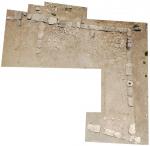Summary (English)
Work continued on the excavation of a residential quarter in zones G and I, in particular buildings G8 and G7. Building G8 was a large structure with a courtyard in the front and attached enclosures for animals. The property was entered through a monumental entrance on the west side of Road V. From here a great courtyard with porticoed roof was entered from the south (room A), while to the north there was a vast open area, probably an animal enclosure.
In the courtyard area (room A), the collapse of a perfectly preserved tile roof was fully uncovered. The great courtyard faced onto the residential part of the building. A long rectangular room was identified as a portico (rooms B-B1), roofed with tiles. On the south side, the roof was found collapsed intact onto the floor levels.
The two rooms C and D, which formed the centre of the house, could be accessed from Portico B. These rooms were excavated down to the floor levels (beaten earth mixed with crushed tufa) and were seen to have been heavily damaged by agricultural activity that had also destroyed the perimeter walls on the west side. A square courtyard (room E) with the remains of housings for posts was uncovered on the north side of room D.
In the area of the large animal enclosure a number of quadrants were excavated down to the latest floor level. There was a large sub-oval hole at the centre filled with stones of different sizes. This was probably the result of clearing in the area in order to make the terrain suitable for agriculture, following the town’s abandonment (4th century B.C.).
A second building was investigated that was situated north of building G8 facing east onto the enclosure area. It is not clear whether this was a separate structure or a part of the same property. It was made up of two elongated rectangular rooms (A and B). The entrance must have been on the east side.
A votive deposit with a double-nozzled lamp placed upside down on the ground was uncovered in the south corner of room A. The lamp dates to the second half of the 6th century B.C.
Three intact infant burials inside impasto pithoi were found next to the outer perimeter walls of the two buildings. Two were placed one inside the other (those west of building G7) and contained only a few cranium fragments. No grave goods were present. The vessel type and find context date the burials to the second half of the 6th century B.C.
Director
- Francesco D’Andria, Università del Salento.
Team
- Laura Masiello - Soprintendenza per i Beni Archeologici della Puglia
- Corrado Notario - Università del Salento
Research Body
- Università del Salento, Dipartimento di Beni Culturali
Funding Body
- A.C.R.I. (Associazione delle Casse di Risparmio Italiane)
- Comune di Cavallino
- Regione Puglia
- Università del Salento






![Download [PDF]](/excavation/skins/fasti/images/results/download_sml.png)


